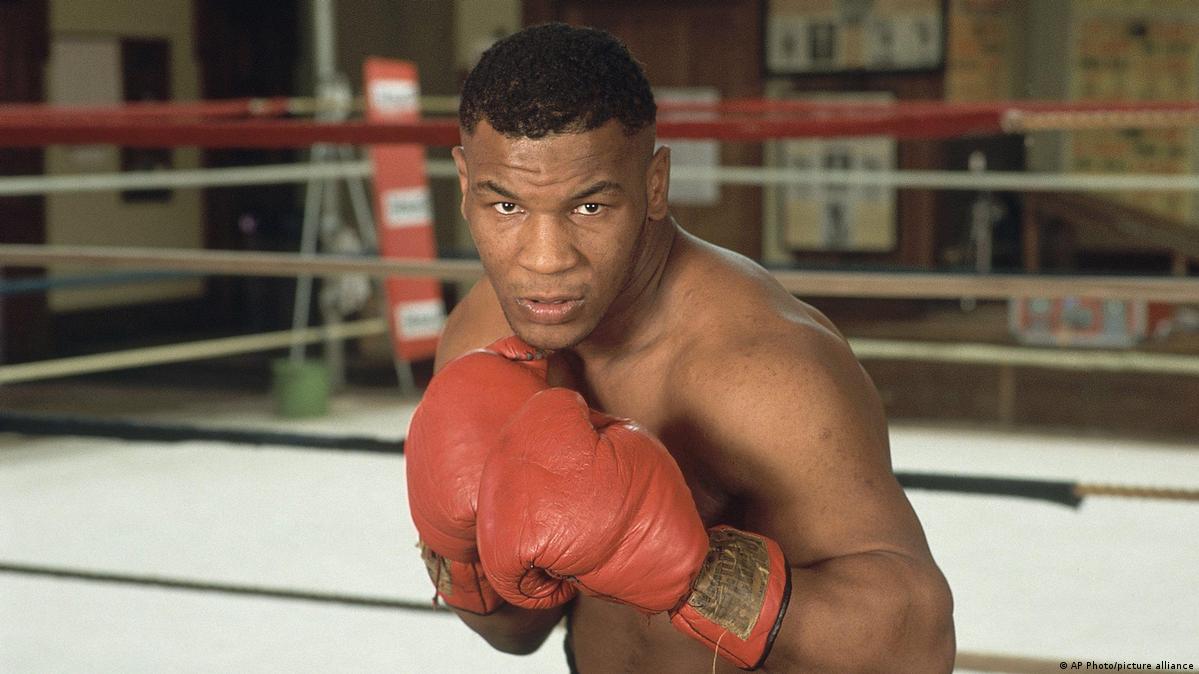
Mike Tyson: From the Mean Streets to Boxing Royalty
Mike Tyson: 7 Day Workout Routine -Mike Tyson’s journey from the mean streets of Brooklyn to the pinnacle of boxing greatness is a compelling narrative that transcends the boundaries of sports. Born on June 30, 1966, Tyson’s early years were marked by hardship, resilience, and the transformative power of boxing.
Humble Beginnings in Brooklyn
Growing up in the tough neighborhoods of Brooklyn, New York, Tyson faced the harsh realities of urban life.
Mike Tyson, born on June 30, 1966, faced numerous tough challenges during his upbringing that significantly influenced his life. Growing up in Brownsville, Brooklyn, a neighborhood known for its poverty and crime, Tyson experienced a turbulent childhood marked by adversity. Some of the tough challenges he faced include:
- Poverty and Dysfunction: Tyson grew up in poverty, surrounded by a challenging and often dysfunctional environment. Raised by a single mother, Lorna Mae Tyson, he faced financial struggles and lacked the stability that many take for granted.
- Criminal Involvement: At a young age, Tyson found himself involved in petty crime and street fights. His environment exposed him to a world of delinquency, and he frequently clashed with the law, leading to his enrollment in a juvenile detention center.
- Loss of a Parental Figure: Tyson’s troubled childhood was further compounded by the loss of his father, Jimmy Kirkpatrick, who abandoned the family when Tyson was just two years old. The absence of a positive male role model left a void in his life.
- Bullying and Isolation: Tyson’s lisp and high-pitched voice made him a target for bullying during his early years. The physical and emotional challenges he faced further fueled his aggressive nature, eventually channeled into the boxing ring.
- Institutionalization: Tyson’s involvement in criminal activities led to his institutionalization in a juvenile detention center. It was during his time there that he discovered boxing as an outlet for his aggression, setting the stage for his future success.
Despite these formidable challenges, Tyson found solace and purpose in boxing. Under the guidance of Cus D’Amato, he transformed his life and became one of the most iconic and successful boxers in history. Tyson’s ability to overcome adversity, both in and out of the ring, has contributed to the complex and compelling narrative of his life.
Raised by a single mother, he found himself navigating a challenging environment where trouble lurked around every corner. The streets became both a playground and a battleground, shaping Tyson’s character and instilling in him a sense of survival.
The Turning Point: Mentorship and Boxing
A pivotal moment came when Tyson, then a troubled teenager, crossed paths with Bobby Stewart, a counselor at a juvenile detention center and a former boxer. Recognizing Tyson’s raw talent and potential, Stewart became a mentor and introduced the young Tyson to the world of boxing. Under Stewart’s guidance, Tyson’s natural athleticism and ferocity were channeled into the disciplined art of boxing.
Soon after, Tyson’s talents caught the attention of legendary trainer Cus D’Amato, who became not only a coach but a father figure to the aspiring young boxer. Under D’Amato’s tutelage, Tyson honed his skills, and his rise in the amateur ranks was nothing short of meteoric.

Rapid Ascent to Boxing Stardom
In 1985, at the age of 18, Mike Tyson made history by becoming the youngest heavyweight champion in boxing. His speed, power, and aggressive fighting style made him an unstoppable force in the ring. The world was captivated by Tyson’s dominance, and his larger-than-life persona transcended the sport. The “Baddest Man on the Planet” had arrived. This article will explore Iron Mike Tyson: 7 Day Workout Routine as well as look at some of his bio.
The Complex Legacy
While Tyson’s early years were marked by triumphs in the ring, his personal life was tumultuous. Legal issues, controversies, and a series of personal setbacks added layers to the narrative of a man whose life was as intense outside the ring as it was inside.
Mike Tyson’s early years remain a testament to the transformative power of mentorship, discipline, and the indomitable spirit that can emerge from even the most challenging circumstances. His journey from the tough streets of Brooklyn to the pinnacle of boxing glory is a story of resilience, redemption, and the enduring legacy of one of the greatest fighters in the history of the sport. Tyson lost his beloved mentor and trainer, Cus D’Amato, when he was just 19 years old. D’Amato played a pivotal role in Tyson’s life, providing guidance and support. His death left Tyson grappling with the loss of a father figure at a critical juncture in his career.
Mike Tyson: 7 Day Workout Routine Overview
Mike Tyson, the former professional boxer and undisputed heavyweight champion, followed an intense and disciplined workout routine during his prime years. While specific details may not be exhaustive, the key components of Mike Tyson’s workout routine included:
- Boxing Training:
- Shadow Boxing: Tyson incorporated shadow boxing into his routine, a practice where a boxer moves around as if in a fight, throwing punches at the air.
- Heavy Bag Work: Training with a heavy bag helped Tyson develop power, speed, and precision in his punches.
- Strength Training:
- Weightlifting: Tyson engaged in weightlifting to build strength. His workouts included compound exercises such as squats and deadlifts.
- Bodyweight Exercises: Tyson also used bodyweight exercises like push-ups and sit-ups to enhance his strength and endurance.
- Cardiovascular Exercise:
- Running: Long-distance running and roadwork were crucial for building stamina and cardiovascular fitness.
- Speed and Agility Training:
- Cone Drills: Tyson worked on his agility and footwork using cone drills to improve his movement in the ring.
- Jump Rope: Jumping rope was a regular part of his routine, contributing to foot speed and coordination.
- Sparring Sessions:
- Regular sparring sessions with skilled opponents were an essential component of Tyson’s training to sharpen his boxing skills and adaptability.
- Diet and Nutrition:
- Tyson maintained a strict diet to support his training. His diet included high-protein foods and nutritional supplements.
- Rest and Recovery:
- Recognizing the importance of rest, Tyson ensured an adequate amount of sleep and recovery between training sessions.

Mike Tyson’s workouts were characterized by their intensity and focus on explosive power, speed, and conditioning—attributes that contributed to his success in the boxing ring. It’s important to note that Tyson’s training routine evolved throughout his career, and his methods may have varied during different phases.


Mike Tyson: 7 Day Workout Routine
Mike Tyson, renowned for his explosive power and speed in the boxing ring, followed a rigorous training routine to prepare for his matches. Keep in mind that this is a generalized example and not an exact representation of Tyson’s personal routine. Additionally, any new workout plan should be tailored to individual fitness levels and goals, and it’s advisable to consult with a fitness professional or healthcare provider before starting.
Day 1: Cardio and Agility Training
- Jump Rope: 15 minutes
- Shadow Boxing: 3 rounds x 3 minutes
- Sprint Intervals: 8 sets x 100 meters
- Agility Drills: Ladder drills, cone drills
Day 2: Strength and Power
- Deadlifts: 4 sets x 6-8 reps
- Box Jumps: 3 sets x 10 reps
- Medicine Ball Slams: 3 sets x 12 reps
- Plyometric Push-Ups: 3 sets x 10 reps
Day 3: Boxing Skills and Sparring
- Heavy Bag Work: 5 rounds x 3 minutes
- Focus Mitts with Trainer: 3 rounds x 3 minutes
- Sparring Sessions: Controlled rounds with sparring partners
Day 4: Cardio and Endurance
- Long-Distance Run: 5 miles
- Cycling or Swimming: 30 minutes
- Jump Rope: 10 minutes
Day 5: Speed and Reflex Training
- Speed Bag Work: 3 rounds x 3 minutes
- Double-End Bag: 3 rounds x 3 minutes
- Reaction Drills: Quick movements and dodging exercises
Day 6: Strength and Core
- Squats: 4 sets x 8-10 reps
- Russian Twists: 3 sets x 20 reps
- Plank Variations: Front plank, side plank
- Neck Exercises: Resistance training for neck strength
Day 7: Rest or Active Recovery
- Light activities such as walking or stretching.


Notes:
- Intensity: Tyson’s training was known for high intensity and explosive movements.
- Volume: Workouts were often high in volume to build endurance.
- Rest: Adequate rest between sets and after intense workouts.
- Nutrition: A well-balanced diet with a focus on lean protein, carbohydrates, and hydration is crucial for recovery. Nutritional supplementation is recommended where the body is being stressed physically as during boxing training and workouts.
This routine is a generalized example and may not precisely reflect Tyson’s actual training. Adjustments should be made based on individual fitness levels and goals. Consulting with a fitness professional can provide personalized guidance and ensure safe and effective workouts.




